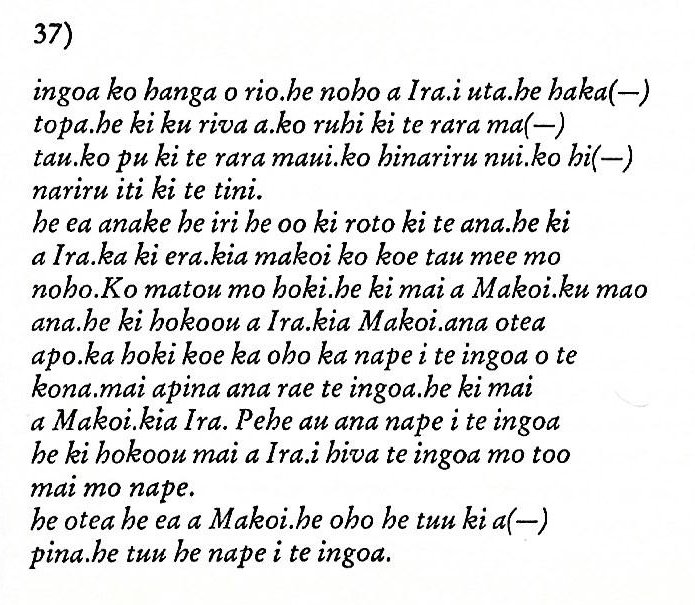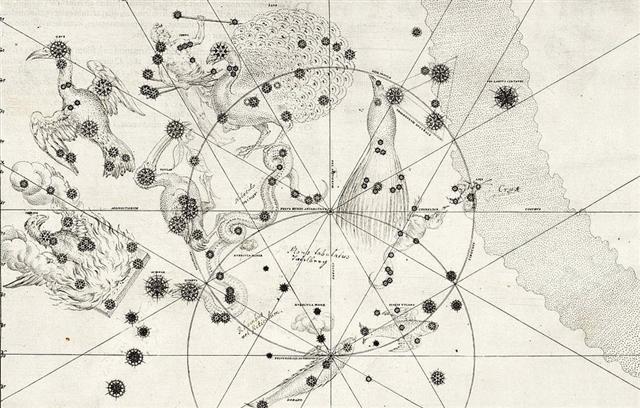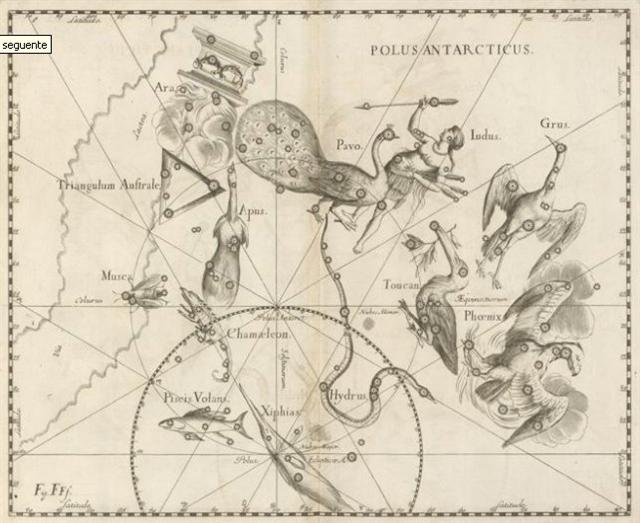
|
he otea ki te ha o te
raa.he ea hokoou anake |
It
grew light on the fourth day, and they all
got up (together). They climbed down, went
on, and arrived at the bay. They hurried,
went into the water, and reached the islet
(off the shore). The wave began to move, and
they all rode the wave (literally, 'they
turned their lower body into the position of
a turtle, coasted like a sled, they all came
in the position of a turtle'). |
| he turu he
oho he tuu ki mua ki te hanga he rerere |
| he iri he
tuu ki runga ki te motu he tata mai te va(-) |
| ve.he tiaeve
mai i te honu he pei he oho mai te |
| honu anake. |
| he oho mai
te Honu a Ira.a te
rara matau.he hi(-) |
Ira
rode the wave [Wave] toward the right side.
He looked diagonally [he hira] toward
the land, looked in the direction of Ruhi
Hepii, and the ornament of Ruhu Hepii [ruhi
hePii] shone brightly [he rapa]. |
| ra mai te
mata a uta he ui mai ruhi hepii |
| he rapa atu
te rei.mai ruhi
hePii. |
| On
Mangareva they said te rara maori for
the right hand ('branch'). In Manuscript E
we should here probably read te rara
matau as te rara ma'tau - see for
instance a te tapa mata'u o te haga,
on the right side of the bay. In contrast
should te rara maui (cfr E:32) be
read as te rara maúi - as in te
va'e mata'u, te va'e maúi, right foot,
left foot.
Rei.
1. To tread, to trample on:
rei kiraro ki te va'e. 2. (Used
figuratively) away with you! ka-rei
kiraro koe, e mageo ê, go away, you
disgusting man. 3. To shed tears: he rei
i te mata vai. 4. Crescent-shaped breast
ornament, necklace; reimiro, wooden,
crescent-shaped breast ornament; rei
matapuku, necklace made of coral or of
mother-of-pearl; rei pipipipi,
necklace made of shells; rei pureva,
necklace made of stones. 5. Clavicle. Îka
reirei, vanquished enemy, who is kicked
(rei). Vanaga. T. 1. Neck. 2.
Figure-head.
Rei mua
= Figure-head in the bow.
Rei muri = Figure-head in the
stern. Henry. Mother of pearl;
rei kauaha,
fin. Mgv.:
rei, whale's tooth. Mq.:
éi,
id. This is probably associable with the
general Polynesian
rei,
which means the tooth of the cachalot, an
object held in such esteem that in Viti one
tooth (tambua)
was the ransom of a man's life, the ransom
of a soul on the spirit path that led
through the perils of Na Kauvandra to the
last abode in Mbulotu. The word is
undoubtedly descriptive, generic as to some
character which Polynesian perception sees
shared by whale ivory and nacre.
Rei kauaha
is not this
rei; in the Maori
whakarei
designates the carved work at bow and stern
of the canoe and Tahiti has the same use but
without particularizing the carving:
assuming a sense descriptive of something
which projects in a relatively thin and flat
form from the main body, and this describes
these canoe ornaments, it will be seen that
it might be applied to the fins of fishes,
which in these waters are frequently
ornamental in hue and shape. The latter
sense is confined to the Tongafiti
migration. Reirei, to trample down,
to knead, to pound. Pau.: Rei-hopehopega,
nape. Churchill. |
| he hakahoki
he oho te honu a te rara maui |
He
went back out into the sea, and the movement
of the wave was toward the left side. Again
he glanced, this time in the direction of
Pu, and the ornament of Pu shone brightly. |
| he hira te
mata hokoou a pu.he rapa mai te |
| rei o pu. |
| he hakahoki
hokoou a vaenga
he rapa mai |
Again he went back into the sea. From the
middle, the two necklaces of the two
figurines shone (toward him). |
| te tuitui
reipa.erua o te ngao o te moai erua |
|
Vae.
Foot, leg; te va'e mata'u, te va'e maúi,
right foot, left foot. Va'e ruga,
va'e raro, quick and light, without
detour (lit.: foot up, foot down). Ka-oho
koe ki a nua era va'e ruga va'e raro, ina
ekó hipa-hipa, hurry straight to your
mother, do not make any detours. Va'e pau,
misshapen foot, clubfoot. Vae, to
choose. Vaega, middle, centre; i
vaega o, in the middle of. Vanaga. 1.
Foot, paw, leg, limb; vae no roto,
drawers; karikari vae, ankle. P Pau.:
vaevae, foot, leg. Mgv.: vaevae,
id. Mq.: vae, id. Ta.: vaevae,
avae, id. 2. Pupil. 3. To choose,
elect, prefer, promote, vote; vavae,
to destine, to choose; vaea (vae
2), pupil. Vaeahatu (vae 1 -
ahatu): moe vaeahatu, to sleep
sprawling with legs extended. Vaega,
center, middle, within, half; o vaega,
younger; ki vaega, among, between,
intermediate. P Pau.: vaega, the
middle. Mgv.: vaega, center, middle.
Mq.: vaena, vavena, vaveha,
id. Ta.: vaehaa, half. Vaehakaroa
(vae 1 - roa): moe
vaehakaroa, to sleep with legs stretched
out. Vaehau (vae 1 - hau
3), pantaloons, trousers. Vaeherehere
(vae 1 - here 1), to attach by
the paw. Vaerere (vae 1 -
rere 1), to run. Churchill. Ta.: 1.
Timbers of a boat. Ha.: wae, knees,
side timbers of a boat. 2. To share out.
Sa.: vae, to divide, to share. Ma.:
wawae, to divide. Churchill. |
| he oho mai
te honu he tomo a rio.he nape iho i te |
His ride on the
wave ended in Rio, |
|
E:37 |
| ingoa ko
hanga o rio.he noho a Ira.i uta.he haka(-) |
and
therefore the name 'Hango O Rio' was given.
Ira remained [he noho] on shore [i
uta], pondered [he hakatopa], and said,
'This is well [riva] done! Ruhi to the right, Pu to
the left, and Hinariru Nui and Hinariru Iti
in the middle [ki te tini]'. |
| topa.he ki
ku riva.a ko ruhi ki te rara ma(-) |
| tau.ko pu ki
te rara maui.ko hinariru nui.ko |
| hinariru iti
ki te tini. |
| he ea anake
he iri he oo ki roto ki te ana.he ki |
They all [anake] got up [he ea],
climbed up [he iri], and entered into
[he oo ki roto ki] the cave [te
ana]. Ira said the following to Makoi:
'You [ko koe] are the one who shall
stay here. We [ko matou], on the
other hand, have to turn around'.
Makoi replied, 'All right with me!'
Then Ira continued to speak to Makoi:
'Tomorrow, when it grows light, set out [hoki
koe] and name the places [te kona] beginning with
Apina'.
Makoi replied, 'How [pehe] shall I
[au] give the names?'
Again [hokoou] Ira spoke, 'In Hiva
are the names that are to be taken to name
(the places of the new land).' |
| a Ira.ka ki
era.kia makoi ko koe tae mee mo |
| noho.Ko
matou mo hoki.he ki mai a Makoi.ku mao |
| ana.he ki
hokoou a Ira.kia Makoi.ana otea |
| apo.ka hoki
koe ka oho ka nape i te ingoa o te |
| kona.mai
apina ana rae
te ingoa.he kia mai |
| a Makoi.kia
Ira. Pehe au ana nape i te ingoa |
| he ki hokoou
mai a Ira.i hiva te ingoa mo too |
| mai mo nape. |
|
Ku. Verbal prefix, used for past
events the effects of which are still
lasting. The verb then takes the suffix
-ana which is very often contracted to
-á . In familiar conversation the
prefix -ku is often omitted and only
the suffix -á is used. Vanaga. 1. I;
kia ku, me. 2. Verb sign: ku ohoa,
to keep out of the way, absence; ku higaa,
convinced; ku taie te tai, to
overflow, to go beyond; ku magaro, to
reconcile. 3. ? tae he mau ku hoao,
abundance. 4. Akaku, to be moved,
affected; hakaku, to groan. Mgv.:
ku, an exclamation, a cry used when one
has hit the mark aimed at. Mq.: ú, an
exclamation of sorrow. 5. Gaoku, to
eat greedily. Mgv.: ku, to be
satiated, glutted. Churchill.
... If we can equate
mulApin (Triangulum) with the Easter
Island location Apina Nui, then we
could guess Apina Iti was the
Southern Triangle.

The Polynesians could
not end a word with the consonant 'n' and
therefore the famous mulAPIN should
have become the Easter Island place Apina
... |
|
he otea he ea a Makoi.he oho he tuu ki
a(-) |
It grew light [on the 5th day] and Makoi got up. He set out
and came to Apina. When he arrived there he
gave the name ... |
|
pina.he tuu he nape i te ingoa. |
Here we should notice that when the Sun reached the
Pleiades the Full Moon was at the Southern Triangle:
|
ki te Rei - ku mata
kuku |
te kava |
ka kake te manu |
 |
 |
 |
|
Gb9-5 (205) |
Cb9-6 |
Cb9-7 |
|
CLOSE TO THE FULL MOON: |
|
μ Lupi,
γ Tr. Austr.
(231.3), ο Librae
(231.8) |
ο
Cor. Borealis (232.0),
δ
Lupi (232.1),
φ¹,
ν²
Lupi (232.2),
ν¹
Lupi (232.3),
ε
Lupi (232.4),
φ²
Lupi (232.5),
PHERKAD (The Dim One of
the Two Calves) =
γ
Ursae Min.
(232.6),
ε
Librae (232.7),
η
Cor. Borealis (232.8),
υ
Lupi (232.9)
*191.0 = *232.4 - 41.4 |
ALKALUROPS (The
Herdsman's Lance) =
μ
Bootis
(233.1),
ED ASICH (Male Hyena) =
ι
Draconis
(233.2) |
|
HORA NUI 27 (270) |
28 |
29 |
 |
|
CLOSE TO THE
SUN: |
|
May 8 (128) |
9 |
10 |
|
ZIBAL (Young Ostriches)
= ζ Eridani
(48.0), κ Ceti (48.9) |
τ Arietis (49.7) |
ALGENIB PERSEI
= α Persei
(50.0), ο Tauri (50.2),
ξ Tauri (50.8)
GIENAH (γ Corvi) |
| te kava |
hakagana ki te maro |
te kava |
hakatino hia |
 |
 |
 |
 |
| Cb9-8 |
Cb9-9 |
Cb9-10 |
Cb9-11 (211) |
| CLOSE TO THE FULL MOON: |
| NUSAKAN (Pauper's Bowl) = β Cor. Bor. (234.0), κ¹ Apodis (234.3), ν Bootis (234.7), ζ Librae (234.9) |
θ Cor. Borealis (235.3), γ Lupi (235.6), GEMMA = α Cor. Bor., ZUBEN ELAKRAB = γ Librae, QIN = δ Serpentis, ε Tr. Austr. (235.7), μ Cor. Borealis (235.8), υ Librae (235.9)
SIRRAH (α Andromedae)
|
φ Bootis (236.2), ω Lupi, τ Librae (236.3), ψ¹ Lupi (236.7), ζ Cor. Borealis (236.9) |
κ Librae (237.2), ι Serpentis (237.4), ψ² Lupi, ρ Oct. (237.5), γ Cor. Borealis, η Librae (237.7), COR SERPENTIS = α Serpentis (237.9)
*196.0 = *237.4 - *41.4 |
| HORA NUI 30 (3 * 91) |
TANGAROA URI 1 |
2 (275) |
3 |
|
... In other words, the ancient Druidic religion based on the oak-cult will be swept away by Christianity and the door - the god Llyr - will languish forgotten in the Castle of Arianrhod, the Corona Borealis. This helps us to understand the relationship at Rome of Janus and the White Goddess Cardea who is ... the Goddess of Hinges who came to Rome from Alba Longa. She was the hinge on which the year swung - the ancient Latin, not the Etruscan year - and her importance as such is recorded in the Latin adjective cardinalis - as we say in English 'of cardinal importance - which was also applied to the four main winds; for winds were considered as under the sole direction of the Great Goddess until Classical times ... |
|
CLOSE TO THE SUN: |
|
May 11 |
12 (132) |
13 |
14 |
|
σ Persei (51.6) |
no star listed (52) |
ψ Persei (53.1)
ACRUX (α CRUCIS)
|
δ Persei (54.7) |
| te maitaki - ka hua roa |
te maitaki - oho te vae |
te inoino |
oho te vae |
e inoino |
oho te vae |
 |
 |
 |
 |
 |
 |
| Cb9-12 (212) |
Cb9-13 |
Cb9-14 |
Cb9-15 |
Cb9-16 |
Cb9-17 |
| CLOSE TO THE FULL MOON: |
| π Cor. Borealis, UNUK ELHAIA (Necks of the Serpents) = λ Serpentis (238.1), CHOW = β Serpentis (238.6) |
κ Serpentis (239.3), δ Cor. Borealis, TIĀNRŪ = μ Serpentis (239.5), χ Lupi, (239.6), ω Serpentis (239.7), BA (= Pa) = ε Serpentis, χ Herculis (239.8). κ Cor. Borealis, ρ Serpentis (239.9) |
λ Librae (240.0), β Tr. Austr. (240.3), κ Tr. Austr. (240.4), ρ Scorpii (240.8) *199.0 = *240.4 - *41.4 |
Iklīl al Jabhah-15 (Crown of the Forehead) / Anuradha-17 (Following Rādhā) / Room-4 (Hare)
ξ Lupi, λ Cor. Bor.(241.1), ZHENG = γ Serpentis, θ Librae (241.2), VRISCHIKA = π Scorpii (241.3), ε Cor. Borealis (241.5), DSCHUBBA (Front of Forehead) = δ Scorpii (241.7), η Lupi (241.9) |
υ Herculis (242.3), ρ Cor. Borealis (242.4), ι Cor. Borealis (242.5), θ Draconis (242.6), ξ Scorpii (242.7)
*201.0 = *242.4 - *41.4
SCHEDIR (α Cassiopeiae) |
16h (243.5)
ACRAB (Scorpion) = β Scorpii, JABHAT AL ACRAB (Forehead of the Scorpion) = ω Scorpii (243.3), θ Lupi, RUTILICUS = β Herculis (243.5), MARFIK (Elbow) = κ Herculis (243.7), φ Herculis (243.8) |
| TANGAROA URI 4 |
5 |
6 |
7 (280) |
8 |
9 |
| Egyptian hand |
 |
Phoenician kaph |
 |
Greek kappa |
Κ (κ) |
|
Kaph is thought to have been derived from a pictogram of a hand (in both modern Arabic and modern Hebrew, kaph means palm/grip) ...
... The manik, with the tzab, or serpent's rattles as prefix, runs across Madrid tz. 22 , the figures in the pictures all holding the rattle; it runs across the hunting scenes of Madrid tz. 61, 62, and finally appears in all four clauses of tz. 175, the so-called 'baptism' tzolkin. It seems impossible, with all this, to avoid assigning the value of grasping or receiving. But in the final confirmation, we have the direct evidence of the signs for East and West. For the East we have the glyph Ahau-Kin, the Lord Sun, the Lord of Day; for the West we have Manik-Kin, exactly corresponding to the term Chikin, the biting or eating of the Sun, seizing it in the mouth.

 
The pictures (from Gates) show east, north, west, and south; respectively (the lower two glyphs) 'Lord' (Ahau) and 'grasp' (Manik). Manik was the 7th day sign of the 20 and Ahau the last ... |
|
| CLOSE TO THE SUN: |
| May 15 (365 + 135) |
16 (136) |
17 |
18 |
19 |
20 |
|
Al Thurayya-27 (Many Little Ones) / Krittikā-3 (Nurses of Kārttikeya) / TAU-ONO (Six Stones)
ATIKS = ο Persei, RANA (Frog) = δ Eridani (55.1), CELAENO (16 Tauri), ELECTRA (17), TAYGETA (19), ν Persei (55.3), MAIA (20), ASTEROPE (21), MEROPE (23) (55.6) |
Hairy Head-18 (Cockerel) / Temennu-3 (Foundation Stone)
ALCYONE (56.1), PLEIONE (28 Tauri), ATLAS (27 Tauri) (56.3) |
MENKHIB (Next to the Pleiades = ζ Persei (57.6)
PORRIMA (γ Virginis) |
ZAURAK (The Boat) = γ Eridani (58.9) |
λ Tauri (59.3), ν Tauri (59.9) |
4h (60.9)
JĪSHUĬ = λ Persei (60.7)
COR CAROLI (α Canum Ven.) |
 |

|

